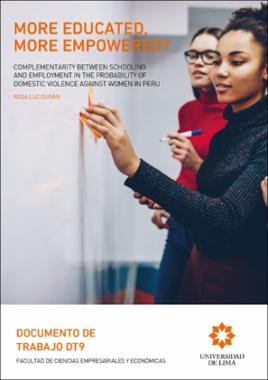| dc.contributor.author | Durán Fernández, Rosa Luz | |
| dc.contributor.other | Durán Fernández, Rosa Luz | |
| dc.date.accessioned | 2020-10-08T13:00:31Z | |
| dc.date.issued | 2019 | |
| dc.identifier.citation | Durán, R. L. (2019). More educated, more empowered? Complementarity between schooling and employment in the probability of domestic violence against women in Peru. Documento de Trabajo de Economía, 9. Facultad de Ciencias Empresariales y Económicas | es_PE |
| dc.identifier.uri | https://hdl.handle.net/20.500.12724/11646 | |
| dc.description.abstract | In Peru, in 2017, 7 out of 10 women who ever had a couple were victims of violence from their
partners, whether in a psychological, physical or sexual way. The available statistics indicate that
women with higher levels of education or with a job, face a greater likelihood of violence in their
homes, yet these aggregate numbers could be misleading because they do not account for situations
in which education and employment do function as violence mitigators. Using pooled data from
2008-2017 of the Demographic and Family Health Survey (ENDES), and with the object of identifying
which concrete combinations of education and employment act as a protective barrier for women
affected by domestic violence, this paper examines the impact of schooling and the employment
status of women for different configurations of the couple's education, under the premise that both,
the educational level of each member of the couple and the educational gap between the two,
involve different balances of power that determine different outcomes of violence within the
household. Additionally, this paper analyzes the complementarity between the effects of education
and employment, and finds that, examined separately, greater schooling and having a job, both
increase the probability of being a victim of recent violence, while, when considered together (that
is, when education and employment interact), they reduce violence. This effect varies depending on
the schooling gap between the members of the couple and the level of education of the husband. | es_PE |
| dc.format | application/pdf | |
| dc.language.iso | eng | |
| dc.publisher | Universidad de Lima, Facultad de Ciencias Empresariales y Económicas | |
| dc.rights | info:eu-repo/semantics/openAccess | * |
| dc.rights.uri | https://creativecommons.org/licenses/by-nc-sa/4.0/ | * |
| dc.source | Repositorio Institucional - Ulima | |
| dc.source | Universidad de Lima | |
| dc.subject | Violencia contra las mujeres | es_PE |
| dc.subject | Trabajo | es_PE |
| dc.subject | Mujeres | es_PE |
| dc.subject | Educación | es_PE |
| dc.subject | Violence against women | es_PE |
| dc.subject | Labor | es_PE |
| dc.subject | Women | es_PE |
| dc.subject | Education | es_PE |
| dc.subject | Perú | es_PE |
| dc.title | More educated, more empowered? Complementarity between schooling and employment in the probability of domestic violence against women in Peru | es_PE |
| dc.type | info:eu-repo/semantics/workingPaper | |
| dc.publisher.country | PE | |
| dc.type.other | Documento de trabajo de economía | |
| dc.subject.ocde | https://purl.org/pe-repo/ocde/ford#5.09.00 | |



